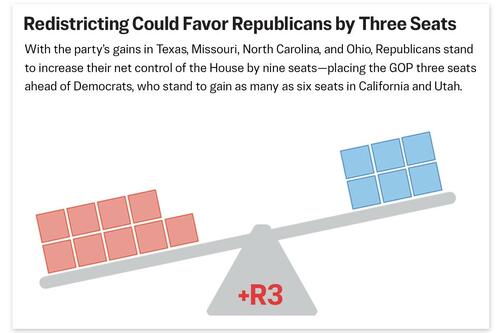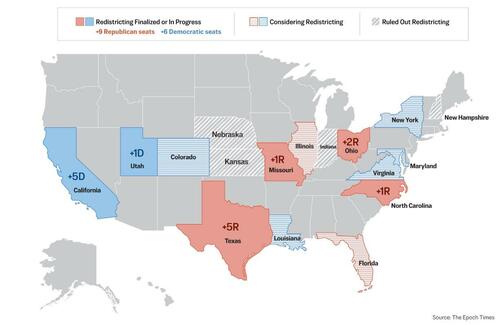Authored by Jackson Richman and Joseph Lord via The Epoch Times,
The future control of the U.S. House of Representatives hangs in the balance as states move to redistrict their congressional maps ahead of the 2026 midterm elections.
A spate of redistricting efforts began earlier this year when Texas approved a map that would grow Republicans’ control of the state’s House delegation. California then responded in kind, approving a map to increase Democrats’ control by the same margins.
Since then, a flurry of other states have finalized redistricting, are moving toward doing so, or are considering proposals.
As things stand, Republicans enjoy a slight advantage, standing to gain three more seats than Democrats.
Here’s a breakdown of which states have been doing what, how the math works, the local legal challenges and politics, and what it might mean for the midterms.
States That Have Redistricted Their Maps
Texas
The Lone Star State added five new Republican-leaning districts in response to a letter from the Department of Justice alleging that some districts in the state were unconstitutionally drawn by grouping minorities into a majority. President Donald Trump signaled his support for the state’s redistricting.
The redistricting was not without a battle, though. State Democrats at one point left Texas to prevent a quorum in the state legislature.
The new map prompted Rep. Lloyd Doggett, a Democrat, to announce his retirement.
SEAT CHANGE: R+5
California
Voters approved a ballot measure on Nov. 4 to counter Texas’s changes, adding five new Democratic-leaning districts in line with a request from California Gov. Gavin Newsom.
The measure, Proposition 50, garnered 64.6 percent support from the state electorate.
Proposition 50 is the subject of a lawsuit by the California Republican Party. The Department of Justice has joined the suit.
SEAT CHANGE: D+5
Missouri
A newly drawn map in the state could help the GOP pick up an additional seat.
Gov. Mike Kehoe signed off on the new map in September after the state legislature approved it.
“Missourians are more alike than we are different, and our values, across both sides of the aisle, are closer to each other than those of the congressional representation of states like New York, California, and Illinois,” he said at the time.
The seat targeted belongs to Rep. Emanuel Cleaver (D-Mo.).
The St. Louis seat, held by Rep. Wesley Bell (D-Mo.), is protected under the Voting Rights Act.
SEAT CHANGE: R+1
North Carolina
Likewise, North Carolina’s new map—approved by the legislature in October—could give the GOP an additional seat.
Although the state has voted for Trump and Republicans in most elections in recent years, North Carolina is often considered a swing state.
Currently, the GOP controls 10 of the state’s 14 congressional seats.
Only one of those seats, held by Rep. Don Davis (D-N.C.), is a potential target. Gov. Josh Stein, a Democrat, did not have the power to veto the new map.
SEAT CHANGE: R+1
Utah
After a judge struck down the map created by Republicans after the 2020 census, the Beehive State created a new Salt Lake City-based competitive seat for Democrats.
Currently, the state’s four congressional districts are split between Salt Lake City and the outlying rural areas. Redistricting would dilute the congressional map and its lines.
Republicans are planning to appeal the decision to the Utah Supreme Court. Former Rep. Ben McAdams (D-Utah) could run for the seat.
SEAT CHANGE: D+1
States Considering Redistricting Their Maps
Colorado
Democrat gubernatorial candidate Phil Weiser, currently the Centennial State’s attorney general, expressed support for a possible constitutional amendment, which would need to be voted on by voters.
Colorado has become increasingly a safe Democratic state, with Republicans having last won the state in the 2004 election.
It is unknown which districts would be targeted, though Colorado’s congressional delegation includes four Republicans: Reps. Lauren Boebert, Jeff Crank, Jeff Hurd, and Gabe Evans.
Florida
In the Sunshine State, a special committee has been formed to take up the redistricting issue.
Gov. Ron DeSantis has expressed approval for redistricting.
“I think the state is malapportioned,” he said. “So I do think it would be appropriate to do a redistricting in the mid-decade. So we’re working through what that would look like, but I can tell you, just look at how the population has shifted in different parts of the state over a four-to-five-year period. It’s been really significant.”
Florida has shifted politically in recent years, moving from a swing state in presidential elections to a solidly Republican state.
Currently, Republicans control 20 of the state’s 28 congressional districts.
Illinois
House Minority Leader Hakeem Jeffries (D-N.Y.) has urged Democrats in the Land of Lincoln to redraw the district map.
“We are going to support efforts to make sure that there are fair maps all across the country in the face of what Republicans are endeavoring to do,” he told reporters, accusing Republicans of gerrymandering.
Gov. JB Pritzker has said that all options are on the table. This could include potentially changing Republican districts to include larger portions of blue-leaning Chicago.
In the Democrat-dominated state, Republicans hold three of the state’s 17 congressional seats.
New York
Democrat state lawmakers have suggested a constitutional amendment that would need to be approved twice by the legislature and then by voters.
Gov. Kathy Hochul has expressed support for redistricting in the solidly Democratic state.
“All’s fair in love and war. We’re following the rules. We do redistricting every 10 years,” she said. “But if there’s other states violating the rules and are trying to give themselves an advantage, all I’ll say is, I’m going to look at it closely with Hakeem Jeffries.”
Democrats currently control 19 of the state’s 26 congressional districts.
Louisiana
Lawmakers are facing court challenges to Louisiana’s current map, approved in January 2024.
Some voters brought suit against the map, claiming it violates the Voting Rights Act. The status of this challenge is in limbo as lawmakers await the federal Supreme Court’s decision, but steps have been taken to push back primary elections in case the maps need to be redrawn.
Democrats hold two of the state’s six congressional seats.
Maryland
On Nov. 4, Gov. Wes Moore launched the Governor’s Redistricting Advisory Commission to consider redrawing the state’s maps in favor of Democrats.
However, the push has faced challenges in the state Legislature, with the Democratic state Senate president rejecting the notion outright.
Rep. Andy Harris is the state’s sole Republican member.
States Moving to Redistrict Their Maps
Virginia
Following the 2025 elections, Democrats in Virginia now have a clear path to move forward with redistricting efforts in the commonwealth to favor Democratic candidates.
Gov.-elect Abigail Spanberger will enter office in January with control of the governor’s mansion, a Democratic lieutenant governor and attorney general, and 64 Democratic seats in the state’s House of Delegates.
Democrats already hold the Senate, where seats weren’t on the ballot in 2025.
Currently, Democrats control six of the state’s 11 congressional districts.
Ohio
On Oct. 31, the Ohio Redistricting Commission unanimously gave the green light to a new congressional district map put forward by the state’s GOP majority.
The new maps, if finalized, could increase the number of Republicans in the state’s congressional delegation from 10 to 12.
Ohio was legally required to change its maps ahead of the 2026 election because the previous maps were only valid for four years, given that they had failed to win bipartisan support following the 2020 census.
Democrats see the current map under consideration as their best option to avoid a potentially worse outcome.
States That Have Ruled It Out
Kansas
After pushing for months to bring Republican lawmakers on board with redrawing Kansas’s congressional maps, a push for a special session was abandoned on Nov. 4.
Republicans failed to garner enough support among state House Republicans to redraw the maps, which currently give Republicans 3 seats to 1 for Democrats.
House Speaker Dan Hawkins announced that there were not enough votes in the state’s lower chamber to warrant convening a special session in November, meaning that the issue has, at least for the time being, been ruled out in the state.
Nebraska
Although Gov. Jim Pillen has said he’s “open” to redrawing the maps, lawmakers in Nebraska’s state legislature don’t share his stance.
Such a redraw would doubtless seek to shore up GOP support in outgoing Rep. Don Bacon’s (R-Neb.) Omaha-based district. But at present, there is too much GOP opposition in the state’s unicameral legislature to move forward with any such bid.
At present, any push to redraw the state’s maps seems to have far less than the 33 votes that would be needed to overcome a potential filibuster.
New Hampshire
Gov. Kelly Ayotte has said now is not the time to redistrict.
“The timing is off for this, because we are literally in the middle of the census period,” she said in an interview with WMUR. “And when I talk to people in New Hampshire ... it’s not on the top of their priority list.”
Though Republicans have enjoyed victories on a local level in New Hampshire, the New England swing state has consistently voted with its neighbors in favor of the Democratic Party at the federal level.
Democrats currently control the state’s two congressional districts as well as the state’s two Senate seats.
Indiana
The Trump administration’s efforts to persuade Indiana to redraw its maps hit a major roadblock on Nov. 14. State Senate President Pro Tem Rodric Bray said in a statement that the votes are not there to change the Hoosier State’s congressional map.
“Over the last several months, Senate Republicans have given very serious and thoughtful consideration to the concept of redrawing our state’s congressional maps,” he said. “Today, I’m announcing there are not enough votes to move that idea forward, and the Senate will not reconvene in December.”
Loading recommendations...

